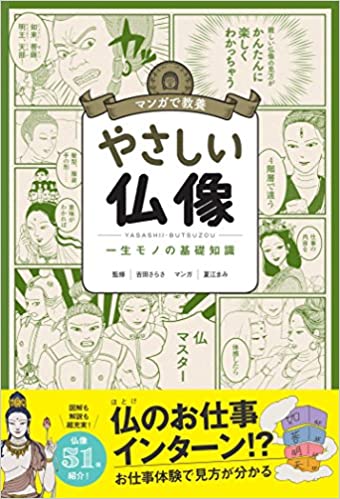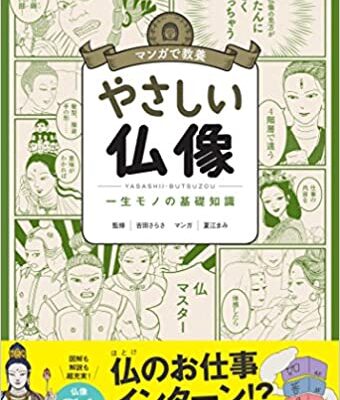吉田さらさ 監修 「やさしい仏像」 朝日新聞出版
京都、奈良に海外の方をお連れする仕事について、有名寺院の仏像はそれなりに見てきたのですが、なかなか頭の中の知識を整理できずに困っていました。東大寺の大仏は大きさに迫力があり、平等院鳳凰堂の阿弥陀様のやさしい顔に癒されたり、三十三間堂では、その数に圧倒されるのですが、一度基礎知識をきちんと付けたいと思っていました。
写真で説明した書籍もあるのですが、あまり馴染めずにいたところ、ある日、梅田から帰る道すがらに立ち寄った本屋で発見したのが本書です。如来、菩薩、明王、天部、羅漢・高僧の順にイラストを用いて説明されています。
もしかしたら、あまりに細かい説明は、逆に案内を受ける人を混乱させてしまうのかもしれませんが、説明側の頭の中で知識が整理されていると、おのずと話す内容もスッキリと相手に伝わるのではないかと期待しています。
どれも同じように見えていた如来の仏像も、釈迦如来、薬師如来、阿弥陀如来、毘盧遮那如来、大日如来のそれぞれに、印相や身に付けているものの違いがわかってきました。また、自分自身の守護仏が大日如来なのですが、金剛界と胎蔵界のどちらに属するかで、印相が異なることも知りました。
後半の章では、もっと知りたい!仏像豆知識として、髪型、服装、台座、光背などをまとめてあります。一通り読んでも、すぐに忘れてしまうと思いますが、お寺で仏さまに会った後に、事典的に引いていくと、少しずつですが知識が記憶に定着していくと思います。(完)

価格:1,320円
(2021/5/8 17:14時点)
感想(4件)
Sarasa Yoshida, Supervisor, “Easy Buddhist Statues”, Asahi Shimbun Publications
With the job of taking overseas visitors to Kyoto and Nara, I have seen a good amount of Buddhist statues at famous temples, but I had a hard time organizing the knowledge in my head. I was impressed by the size of the Great Buddha at Todaiji Temple, soothed by the gentle face of the Amitabha at Byodoin Phoenix Hall, and overwhelmed by the number of statues at Sanjusangendo, but I wanted to get a basic knowledge of them.
There are some books that explain with pictures, but I was not very familiar with them. One day, I stopped by a bookstore on my way back from Umeda and found this book. The book is illustrated in the following order: Buddha, Bodhisattva, Myoo, Tembu, Arhat and High Priest.
Perhaps too detailed explanations may confuse the person being guided, but I expect that if the person who explains has organized knowledge in his or her mind, the content of the explanation will naturally be conveyed to the other person in a clear manner.
Even though all the Buddha images looked the same, I have come to understand the differences in the impressions and the objects worn by the Buddha images of Shakyamuni Buddha, Yakushi Buddha, Amitabha Buddha, Vairocana Buddha, and Dainichi Buddha. I also learned that my own guardian Buddha is Dainichi Buddha, but that he has different hand signs depending on whether he belongs to the Vajrayana or the Garbhadra realm.
In the later chapters, more to know! As trivia about Buddhist statues, there is a summary of hairstyles, clothing, pedestals, haloes, etc. Even if you read through the whole book, you will probably forget about it soon, but if you use it like an encyclopedia after meeting the Buddha at a temple, I think the knowledge will gradually become ingrained in your memory. (End)
Sarasa Yoshida, superviseur, “Easy Buddhist Statues”, Asahi Shimbun Publications
Ayant pour mission d’emmener des visiteurs étrangers à Kyoto et à Nara, j’ai vu un bon nombre de statues bouddhistes dans les temples célèbres, mais j’ai eu du mal à organiser mes connaissances dans ma tête. J’ai été impressionné par la taille du Grand Bouddha du temple Todaiji, apaisé par le doux visage de l’Amitabha du hall du Phoenix Byodoin et submergé par le nombre de statues de Sanjusangendo, mais je voulais en avoir une connaissance de base.
Il existe des livres qui expliquent avec des images, mais je ne les connaissais pas très bien. Un jour, je me suis arrêté dans une librairie en revenant d’Umeda et j’ai trouvé ce livre. Le livre est illustré dans l’ordre suivant : Bouddha, Bodhisattva, Myoo, Tembu, Arhat et Grand Prêtre.
Peut-être que des explications trop détaillées peuvent dérouter la personne guidée, mais je m’attends à ce que si la personne qui explique a organisé ses connaissances dans son esprit, le contenu de l’explication sera naturellement transmis à l’autre personne de manière claire.
Même si toutes les images de Bouddha se ressemblaient, j’ai fini par comprendre les différences dans les impressions et les objets portés par les images de Bouddha Shakyamuni, Bouddha Yakushi, Bouddha Amitabha, Bouddha Vairocana et Bouddha Dainichi. J’ai également appris que mon propre Bouddha tutélaire est le Bouddha Dainichi, mais qu’il a des signes de la main différents selon qu’il appartient au royaume Vajrayana ou au royaume Garbhadra.
Dans les chapitres suivants, il y a plus à savoir ! Comme bagatelles sur les statues bouddhistes, il y a un résumé des coiffures, des vêtements, des piédestaux, des auréoles, etc. Même si vous lisez tout le livre, vous l’oublierez probablement rapidement, mais si vous l’utilisez comme une encyclopédie après avoir rencontré le Bouddha dans un temple, je pense que les connaissances s’ancreront progressivement dans votre mémoire. (Fin)
